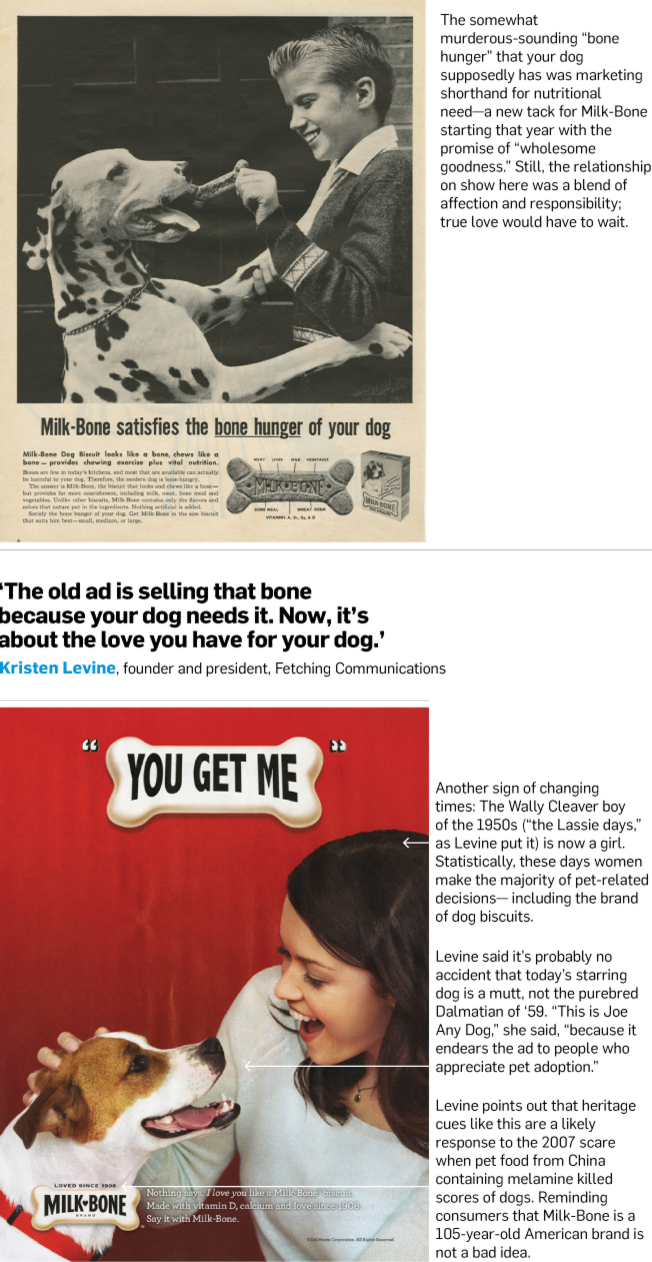Among Rodney Dangerfield’s innumerable one-liners was one complaining about his new pet dog: “His favorite bone is in my arm!” (Hey, it was funny in the ‘80s.) It’s anyone’s guess where the popular association between dogs and bones began. Thoreau wrote about it, as did Jack London. The “This Old Man” nursery rhyme with the refrain “knick-knack paddywhack, give a dog a bone” dates to 1906. And two years later, an American entrepreneur named F.H. Bennett introduced a new brand of dog biscuits called Milk-Bone. Bennett’s near-immediate success lay not only in the (reportedly) tasty recipe he got from a London butcher, but in a stroke of marketing genius: He shaped his biscuits to look like bones.
The association has become so innate that when it comes to marketing said biscuits, the approach hasn’t needed to change very much, as the two ads here prove. It basically goes like this: show dog; show kid feeding biscuit to dog; you’re done. Yet a closer inspection reveals that a refined but important evolution has taken place in Milk-Bone’s approach—and, really, in the whole give-your-dog-a-bone narrative from which it springs. “This new ad says more about the relationship between the person and the pet,” said Kristen Levine, founder and president of pet-marketing firm Fetching Communications. “The old ad is selling that bone because your dog needs it. Now, it’s about the love you have for your dog.”
Before we chase this point any further, here’s something to chew on: According to a 2011 poll by Harris Interactive, 92 percent of dog people (and among pet owners, that’s nearly seven in 10) say that Fido is a full-fledged member of the family. Nearly 60 percent of dogs now sleep in bed with their owners.
Harris doesn’t have comparable data for 1959, the year this vintage ad for Milk-Bone appeared—but it’s a safe bet that most proper suburban couples in Eisenhower-era America did not sleep with the dog. Levine points out that canine ascendancy in the American family is clearly reflected in these two ads—not just in inconspicuous tweaks like a comfortable nylon collar replacing the severe choke chain, but in the context of the biscuit giving itself.
Our crew-cut lad of 1959 seems to be rewarding his dog for doing a trick. Indeed, in 1958 Milk-Bone released a TV spot with the slogan “Say ‘Good Dog’ the Milk-Bone way.” By contrast, the 2013 ad clearly shows pooch and friend on equal footing, and with noticeably more affection. Milk-Bone is also going to considerable lengths to stress the message of love, a word that appears twice in the ad’s copy and in the heart that’s replaced the dash in the Milk-Bone logo itself. “The bone at the top of the ad even looks like a cartoon heart,” Levine added. “The 1959 ad was more about filling a basic need, but now it’s about Milk-Bone being the brand you know and trust because you want the best for your best friend.”
And, clearly, we do. After all, one in three of us buys our dogs holiday presents—and 20 percent of us cook meals for them.
This entry passed through the Full-Text RSS service — if this is your content and you're reading it on someone else's site, please read the FAQ at fivefilters.org/content-only/faq.php#publishers.
via http://news.google.com/news/url?sa=t&fd=R&usg=AFQjCNHyAWh5yrvZ34IZWzXlQpJrz3J2iA&url=http://www.adweek.com/news/advertising-branding/love-has-changed-dog-biscuit-business-154032
Show Konversi KodeHide Konversi Kode Show EmoticonHide Emoticon